How to remove fungus in the bathroom: the best folk and professional ways
On the walls of rooms with high humidity, you can often find mold spots that pose a threat to the health of residents.
Using the information on how to remove the fungus in the bathroom and other rooms, you can get rid of pathogenic microflora using folk or professional means. In this article we will talk about the types of mold and the most effective ways to deal with it.
The content of the article:
Common types of mold
Almost every housewife had to deal with black spots, which are usually localized in the bathroom or other rooms with high humidity.
Such plaque should not be confused with dirt - it is usually caused by certain types of microscopic organisms.
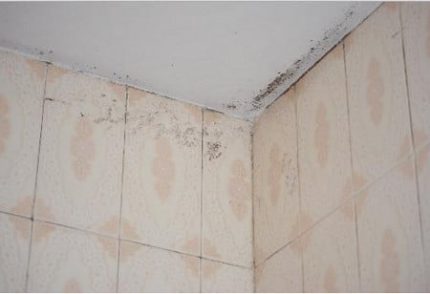
On the walls, floors and ceilings of rooms three common varieties of microflora can parasitize.
Blue stain. This species of simple organisms is able to reproduce only on wood, preferring pine structures.
The blue fungus can be found in baths and saunas built from conifers, but it does not threaten the inhabitants of city apartments.
Decay bacteria (bacterial, brown, white rot) can also reproduce only on a tree, causing the breakdown of cellulose fibers.
It is extremely difficult to remove these microorganisms by stopping the process of wood destruction. You can only take measures in advance by treating the material with special fungicidal solutions.
Black mold. The greatest danger to people is mold fungi, which form black spots.This group includes several representatives of microflora (Chaetomium, Ulocladium, Aspergillus and others).
Able to settle black mold not only on organic surfaces, but also on ceramic tiles, concrete, paint, brickwork.
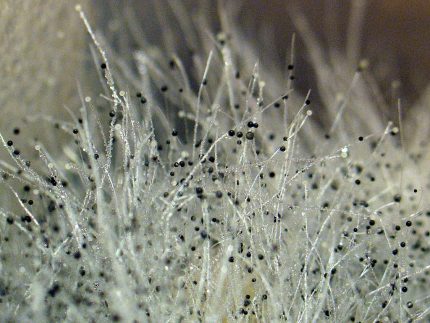
Such microflora should not be ignored; it is advisable to take immediate measures to eliminate it.
What is dangerous fungus on the walls?
Mold that appears in the rooms harms building structures and also negatively affects human health. The fungus that has settled on the walls or ceiling gradually destroys the material on which the colony settled.
This can lead to peeling of plaster, coatings, and in advanced cases, even to the formation of cracks in the walls.
Failure to take appropriate measures may result in partial or complete destruction of individual building elements and even collapse of surfaces. Pathogenic microflora has an extremely harmful effect on the human body, provoking a whole "bunch" of various health problems.
Mold is directly related to the following ailments:
- general depletion of the body;
- dermatoses, mycoses and a number of other skin diseases;
- headaches, dizziness;
- diseases of the respiratory system (from rhinitis and sinusitis to pneumonia and asthma);
- indigestion, nausea;
- articular rheumatism and other problems of the musculoskeletal system.
Prolonged exposure to mold can lead to severe disturbances in the functioning of the lungs, kidneys, liver and other organs.

Particularly sensitive to pathogens are elderly people, children, people with poor health and patients who are undergoing chemotherapy or antibiotics. AT this article You can read more about the harm that mold causes to the human body.
Mildew Prevention
In the air of almost any room, spores of various types of molds are sprayed, however, their germination and reproduction can occur only under certain conditions: humidity more than 30% and a room temperature exceeding +20 ° C.
In order to prevent the formation of colonies of microorganisms, it is necessary to take all measures to eliminate these causes. The fight against humidity is especially important, because in a dry room, mold will not develop even with a warm and hot microclimate.
To prevent mold spots in the room, a number of preventive measures must be strictly observed. Ensure good air circulation in the room. As a rule, in all multi-storey buildings there is a ventilation duct, but in old buildings it often does not cope with work.
The cleaning of the channel will help to rectify the situation (this can be done by a specially called ZhES worker) or additional installation fan.

Even with excellent operation of the hood after taking water procedures or washing, it is advisable to leave the bathroom door open: this helps to air the room and remove excess moisture.
Space overcooling should not be allowed: it is desirable to cover the walls of an insufficiently warm room with a layer of heat insulating material.
With poor heat dissipation of the heated towel rail, it is better to use additional heating equipment. This is especially true for the autumn-winter season, when air temperature decreases and humidity increases.
It is necessary to monitor the appearance of condensation on pipes, furniture and other surfaces of the bathroom. Try dropping droplets immediately with a rag or rag.
It is important to identify and eliminate the causes of increased moisture content in the room on time. It is necessary to constantly monitor the condition of faucets and plumbing devices, as well as the connecting elements.
It is desirable to replace metal pipelines in the bathroom with plastic analogs: they are more resistant to leakage and never sweat.
Do not forget to pay attention to the little things: stagnant water in glasses for toothbrushes can cause the formation of mold on their handles. Fungal colonies can also settle on polymer curtains that separate the bath or shower.
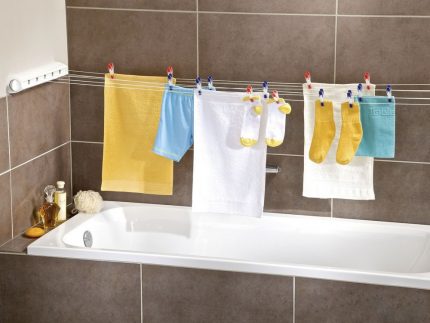
When repairing the bathroom, it is necessary to use special construction and finishing materials that prevent the appearance of the fungus.
It is important to periodically conduct preventive surface treatment using traditional methods or household chemicals specifically designed for this purpose.
The mechanical method of removing the fungus
Finding black spots in the room, the hostess usually takes on a rag or scraper, trying to wash off or scrape off the mold. To get an effective result, you need to know how to properly remove fungal colonies in the bathroom.
First of all, the detected mold areas should be well moistened with water. This manipulation will prevent the spore from getting into the air, which can cause new lesions.
Then you need to take a metal scraper or other similar tool (steel brush, drill with a nozzle for grinding), which will help to carefully remove the affected area.
It is advisable to remove the largest possible layer of coating (plaster, wallpaper, paint); for materials such as concrete and wood, milling is also possible.
In advanced cases, this method is not effective enough, since the mycelium can deeply penetrate even into inorganic surfaces, for example, hide under a tile lining.
In this case, to solve the problem, it will be necessary to carry out a major overhaul, providing:
- release of walls from a decorative covering (a ceramic tile, wall-paper, a paint coat);
- removal from the ceiling of lime or paint;
- replacement of floor finishing material.
When carrying out a major overhaul, it is imperative to treat all surfaces with agents that destroy the fungus.
Preparations (folk or professional) should be applied to an area that is larger in size than the area of the visible distribution of the fungus in order to remove the micro mycelium invisible to the naked eye.
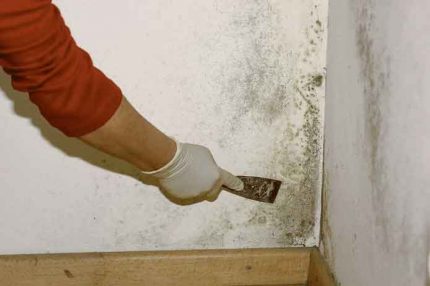
Each surface must be treated at least 2-3 times, each time waiting for the complete drying of the previously applied fungicidal preparation. When performing repairs, it is advisable to use building materials with antifungal additives.
Popular mold removal methods
Since molds have bothered residents for centuries, and household chemicals began to be released not so long ago, the population has gained great experience in using a variety of tools to destroy harmful microflora.
Among the most common drugs that have a pronounced effect, we can name the following.
Option # 1 - copper sulfate
An inexpensive effective tool that can be purchased in gardening, construction or hardware stores. Blue crystals are diluted in warm water in a proportion of 200-300 grams of powder per 10 liters of liquid, after which they are well mixed.
The treatment of the affected surface with the prepared solution is carried out in several stages:
- Mold traces on the walls are cleaned with sandpaper or a spatula.
- The prepared places are wiped with a soap solution, which increases the effectiveness of the agent used.
- The cleaned and washed surfaces give time to dry.
- The wall is treated with copper sulfate (the solution can be applied using a kitchen sponge or sprayer).
- The surface is left for 3-5 hours to dry, after which divorced vitriol is applied again.
- Depending on the degree of fungal infection, the procedure is repeated 2-5 times.
For greater effectiveness, a tablespoon of vinegar can be added to the vitriol solution.
Option # 2 - chlorine-based products
Solutions containing chlorine guarantee the effective destruction of mold: they contain an aggressive component that kills most microorganisms.To combat the fungus, you can use popular chlorine-containing drugs, which are often used in the household to bleach fabrics or clean plumbing, namely "Domestos", "White", Sanita other.
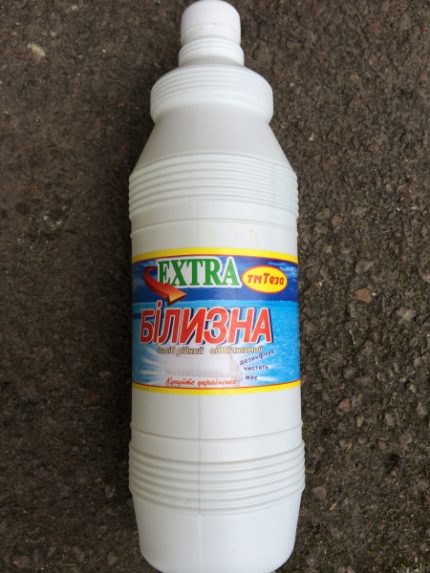
To combat mold colonies, the affected areas and the area around them are treated with a rag that is wetted in an undiluted agent.
For processing tile joints, the drug can be diluted with water in a 1 to 1 ratio, poured into a spray bottle and applied to the joints.
Option # 3 - table vinegar
Almost every house has a 6-9% solution of vinegar, which is widely used in cooking. At the same time, this tool is a good antiseptic that perfectly destroys various types of microflora.
To combat mold should:
- treat the affected area with table vinegar: it is enough to wipe the smooth surface (tile) with a sponge or rag dipped in liquid, and spray loose coatings (plaster, concrete, wood) from the spray gun;
- leave the treated surface for 2-3 hours before drying;
- remove the remains of the fungus with a brush;
- rinse thoroughly with cleaned water;
- ventilate the room well to remove pungent odor.
It should be borne in mind that in some cases from the vinegar on the wall may remain stains.
Other folk remedies for fungus
In addition, the following drugs can be used as antibacterial and fungicidal agents:
- Hydrogen peroxide. A widely used antiseptic, a 3% solution of which can be purchased at a pharmacy. The drug is not toxic and has no pronounced odor. Care must be taken when processing, since peroxide has a clear whitening effect.
- Ammonia. A good tool to remove mold colonies from dense hard surfaces, such as ceramic tiles or glass. To destroy the microflora, the drug purchased at a hardware store is diluted with an equal amount of water, after which the mixture is applied to the infected area with a sponge or spray. The solution is left on the wall for several hours, after which the coating is washed well.
- Baking soda. A natural and safe household antiseptic that will help in the fight against fungus. For processing, a solution is used from a teaspoon of powder mixed in a glass of water. The solution is sprayed on the surface on which the fungus is noticed, or the wall is washed with a sponge moistened in the composition. Rinse off the soda is not necessary, it can be safely left on the tile or other coating.
- Tea tree oil. An environmentally friendly product with a strong pleasant aroma, suitable for the prevention and destruction of small areas of mold. For use, you need to dissolve two teaspoons of essential oil in half a liter of water, which can be purchased at a pharmacy or specialty store. The resulting solution is sprayed onto areas where fungus is suspected. Rinse off the product, but after treatment it is better not to enter the bathroom for 12 hours.
- Creosote. A yellowish liquid with a pungent odor made from tar is used as a solution in alcohol or ether. The drug is recommended to be applied to concrete, tile, plastic panels, brick and other smooth, dense surfaces. After the product has dried, it must be washed off with soap and water. It is undesirable to use creosote for the treatment of wooden structures, since the solution instantly penetrates into loose textures.
- Anthracene Oil. A greenish liquid with a specific odor is produced from coal. Oil is considered a good prophylactic that prevents mold deposits on the walls.
- Borax. Mineral, which is a natural antiseptic. To process the surface with sprouted mold, it is necessary to prepare a solution of 2.5 liters of liquid and 1 cup of borax. After cleaning the wall from stains, a rather thick composition is applied to it with a rag. It is not necessary to wash it off, however, after drying, you can wipe the surface with dry paper to remove protruding crystals. Another option: make a less concentrated solution (a full glass of borax and 4 liters of liquid), and then spray the affected area from the spray gun.
- Camphor balls. To prevent fungal infection in the room, camphor balls can be laid out.
- Iodine. Another prophylactic is iodine vapor. To do this, put a glass of water on a shelf in the bathroom, in which 10 mg of ordinary iodine tincture is diluted. It is advisable that there are no metal objects nearby, since volatile vapors of iodine can cause corrosion.
Do not forget about cleaning “cocktails”.

An effective preparation is also considered a preparation made from 4 parts of water, 2 parts of hydrogen peroxide, 1 part of boric acid, 2 parts of vinegar.
All components mix well, after which a rag or sponge is moistened with the mixture, which processes all affected areas.
Professional methods for killing fungus
With extensive fungal damage to the surfaces of the bathroom, it is better to use professional methods of destroying mold.
Household chemicals
On sale there are many different means to combat pathogenic microflora.
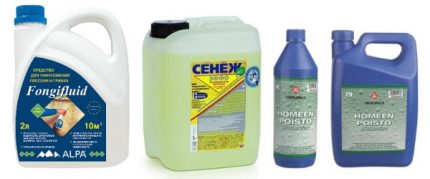
«Mil Kill"- an emulsion, which includes an antiseptic that is safe for human health. The drug is especially recommended for the treatment of complex surfaces made of materials with a finely porous structure.
The same tool can be used to disinfect leaks, as well as to protect structures located in areas of high humidity.
«Isocide"- a line of drugs designed to destroy different types of microflora, typical of rooms with a high content of water vapor. Means can be used for processing bases from wood, stone, concrete, and also used as a base in the preparation of water-soluble paints.
Well done - A modern antibacterial solution that inhibits the development of fungi, mold, algae. It has a pronounced instant result, copes well even with large colonies of microorganisms.
Well suited for sanitation of internal and external surfaces, suitable for the treatment of wooden, plastered or painted structures.
«Titanium"Fungicide. A tool designed to remove fungus and mold from internal and external coatings, without removing the layer of finishing material. The composition can also be used for prevention.
SZAVO (Savo). An effective drug designed to combat pathogenic microflora in rooms where it is difficult to get rid of the high content of water vapor (kitchens, bathrooms, basements, showers).
The manufacturer guarantees the absolute destruction of mold, algae, fungi. The tool is extremely simple to use: it does not require preliminary surface treatment and additional washing.
Astonish - An excellent preparation for removing mold from "light" surfaces that do not require curettage. It can be used to clean polymer shower curtains, plastic furniture, tiles.
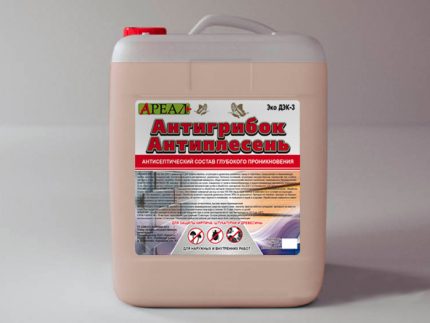
«Antifungal"- a universal tool that can be used to treat areas affected by the fungus, or as a preventive measure. The drug is applied to almost all types of materials: brick, wood, concrete, plaster.
Dali - a completely transparent antiseptic drug made on a water basis. Great for preventing and eliminating fungus on wooden structures.
Domestic and foreign manufacturers also produce a wide range of paints, grouts, primers and other types of building materials, which contain fungicidal components that guarantee surface protection.
On our site there is another article dedicated to the selection antifungal drugs, we recommend reading it.
Remediation and ionization of the room
To combat fungus in the bathroom, the treatment of affected areas with a stream of air is also used, which is additionally enriched with ions and trace elements.
Since special equipment designed for this is quite expensive, work is usually carried out by specially trained professionals.
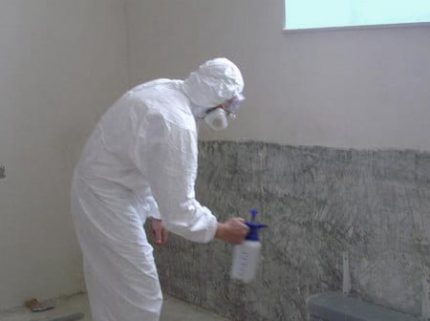
For large-scale mold removal work, aggressive chemicals are also used, the use of which requires special precautions. Processing with such drugs is carried out by trained specialists.
Prevention of the emergence and resettlement of fungal microorganisms should be regularly sanitized important household premises:
Safety rules for processing a room
All mold removal manipulations are dangerous types of work, because when they are performed, harmful fungal spores can get on the skin and mucous membranes.
In addition, when processing surfaces, potent substances are used predominantly, which can cause burns, poisoning and other negative reactions.
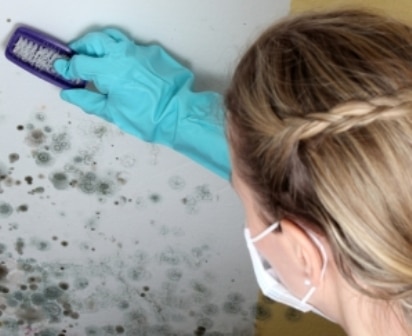
To prevent this from happening, take special precautions.
When carrying out work you should wear:
- durable rubber gloves that protect the palms and wrists;
- respirators or masks for respiratory organs;
- plastic glasses (preferably special, tight to the eye sockets) that provide effective eye protection.
After completion of work, the protective equipment used, especially gloves and respirators, is recommended to be discarded.
When processing the bathroom, it is better to remove all small objects from the room, and large ones - cover with a protective film, which then should be carefully collected and removed.
It is necessary to carry out measures to destroy the fungus in the absence of children and pets.It is advisable to ventilate the treated room well for 2-4 hours, after which it is better not to use the bathroom for 2-3 days.
Conclusions and useful video on the topic
The video below shows how to remove fungal colonies in the bathroom:
The fight against mold should be carried out constantly. After the destruction of the fungus in the bathroom using folk or professional means, it is important to follow all the recommended preventive measures that will help to avoid the appearance of new foci.
Perhaps you know other effective ways to destroy the fungus in the bathroom and you managed to test them in practice? Please tell visitors about our site about them. You can do this by leaving a comment on the article in the block below.

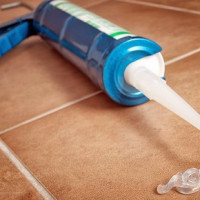 Sealant for the bathroom: types, selection tips and instructions for use
Sealant for the bathroom: types, selection tips and instructions for use 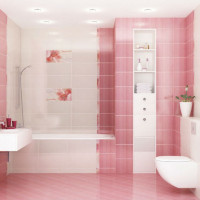 How to calculate the number of tiles in the bathroom: installation methods + calculation procedure
How to calculate the number of tiles in the bathroom: installation methods + calculation procedure  Revision plumbing hatches for the bathroom and toilet: types, placement rules, mounting features
Revision plumbing hatches for the bathroom and toilet: types, placement rules, mounting features 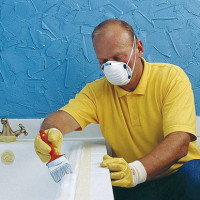 How to choose enamel for bath restoration: a comparative overview of popular products
How to choose enamel for bath restoration: a comparative overview of popular products 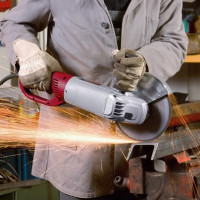 How to work with a grinder: safety measures + instruction manual
How to work with a grinder: safety measures + instruction manual 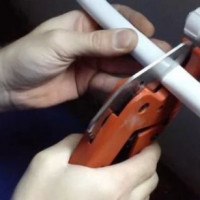 Pipe cutter for polypropylene pipes: an overview of the types of tools and features of working with it
Pipe cutter for polypropylene pipes: an overview of the types of tools and features of working with it  How much does it cost to connect gas to a private house: the price of organizing gas supply
How much does it cost to connect gas to a private house: the price of organizing gas supply  The best washing machines with dryer: model rating and customer tips
The best washing machines with dryer: model rating and customer tips  What is the color temperature of light and the nuances of choosing the temperature of the lamps to suit your needs
What is the color temperature of light and the nuances of choosing the temperature of the lamps to suit your needs  Replacement of a geyser in an apartment: replacement paperwork + basic norms and requirements
Replacement of a geyser in an apartment: replacement paperwork + basic norms and requirements
They fought black mold for a long time - it is the most dangerous and tenacious reptile. Before the holidays, they left the washing machine closed, and after the trip we had these dark spots on the rubber band and on the wall. Air is needed, regular ventilation to reduce the degree of humidity (difficult, especially in the bathroom). We took her out in a few days, but still sometimes I examine everything in the corners. The main thing is not to arrange a “steam room”, moisture and heat - this is what this mold loves!
Wow! I didn’t even know that this mold is so dangerous, not only for walls, ceilings, but especially for my health. There is a black spot on the ceiling in the corner. It was impossible to get rid of him. I'll try to try folk recipes to combat mold. I especially liked the recipes using vinegar, soda, hydrogen peroxide. These are those products that are always at home, and also inexpensive.
I had a similar situation. None of the popular methods helped; I had to use aggressive chemistry. It is called Olympus Stop mold, perhaps it will come in handy.
In a warm and humid room, such as a bathroom, it is very difficult to fight with a fungus. A good tool for repairs (even cosmetic ones) is spent calcium carbide. Those. that solution which remains after gas welding or gas cutting is diluted with water and applied to the walls and ceiling.
A poisonous mixture, but it works flawlessly. If, after this, the surface is painted with lime paints, the effect is guaranteed for many years. Checked by me for 8 years.